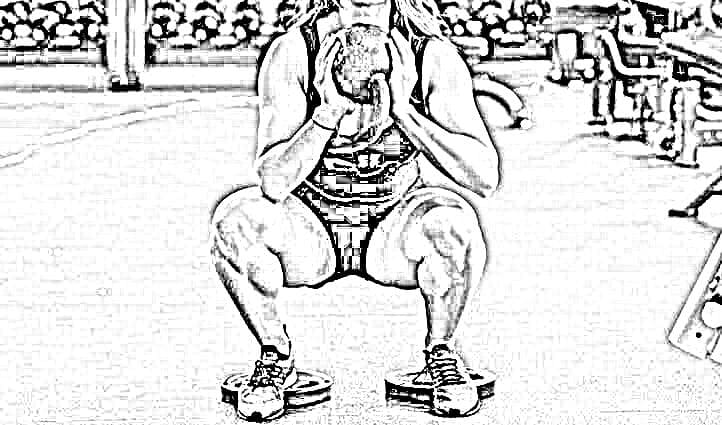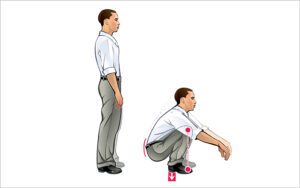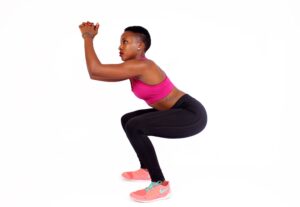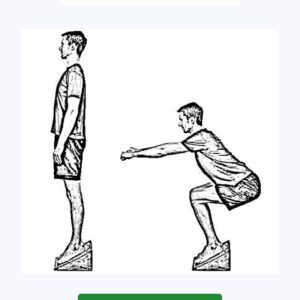
Heels-elevated squats, also known as high-heel squats, is an alteration of the conventional squat, have become a focal point in strength training, offering numerous Benefits and advantages that significantly contribute to lower body development and overall fitness. This modification changes the dynamics of the movement, placing more emphasis on the quadriceps and glutes.
In this article, we will explore the 12 proven benefits of heels elevated squats and explain how they provide each of these benefits.
Before we dive into the scientific backed benefits of heels elevated squats, let’s first have a basic understanding of the exercise.
Understanding Heels Elevated Squats
Heels elevated squats are a variation of the traditional squat exercise that involves placing the heels on an elevated surface, such as weight plates or a small platform
Muscles Worked:
Heels elevated squats works the following muscles:
- Quadriceps
- Hamstrings
- Glutes
- Calves
How to Do It with Proper Form:
- Stand with your feet shoulder-width apart and your toes facing forward.
- Place a weight plate or other small platform under your heels so that they are raised off the ground by about 2-3 inches.
- Stand tall with your core engaged and your back straight.
- Lower your hips back as if you are sitting into a chair, keeping your back straight and your knees in line with your toes.
- Lower until your thighs are almost parallel to the ground, then press through your heels to return to the starting position.
Modifications for Beginners:
- If you have difficulty squatting with your heels elevated, you can start by squatting with your heels flat on the ground.
- You can also use a smaller platform to elevate your heels, or you can simply stand on a small step.
Variations:
- Barbell Heels Elevated Squats: This is a more challenging variation that can be done with a barbell.
- Kettlebell Heels Elevated Squats: This is another challenging variation that can be done with a kettlebell.
- Goblet Heels Elevated Squats: This is a variation that is easier on the back and can be done with a dumbbell or kettlebell.
- Bodyweight Heels Elevated Squats: This is a variation that can be done without any weights.
Now that we have an understanding of this remarkable exercise, let’s explore its amazing benefits

Benefits of Heels Elevated Squats
Here are the 12 science backed benefits of doing heels elevated squats (High heel squats):
Benefit 1: Increased Quadriceps Activation
Heels elevated squats target the quadriceps muscles to a greater extent compared to regular squats. By elevating the heels, the knee angle is altered, placing more stress on the front of the legs. This increased activation leads to greater quadriceps development and strength gains.
Benefit 2: Enhanced Glute Engagement
While regular squats primarily target the glutes, heels elevated squats take it a step further by placing additional emphasis on the glute muscles. The altered mechanics of the exercise activate the glutes more effectively, leading to improved glute development and enhanced overall lower body strength.
Benefit 3: Improved Ankle Mobility
One of the key benefits of heels elevated squats is the improvement in ankle mobility. By elevating the heels, the ankle joint is allowed to achieve a greater range of motion, making it easier to perform deep squats. Over time, this increased mobility can translate to better overall movement patterns and reduced risk of injury.
Benefit 4: Stronger Core Activation
Heels elevated squats require increased core stability to maintain proper form throughout the movement. The elevated heels shift the center of gravity forward, forcing the core muscles to work harder to maintain balance and control. This increased core activation leads to improved core strength and stability.
Benefit 5: Greater Hip Flexibility
Performing heels elevated squats can also help improve hip flexibility. The altered mechanics of the exercise require greater hip mobility to achieve a deep squat position. With regular practice, this can lead to increased hip flexibility, allowing for better movement patterns and reducing the risk of hip-related injuries.

Benefit 6: Improved Balance and Coordination
The challenge of maintaining balance during heels elevated squats can significantly improve balance and coordination. The elevated heels shift the body’s center of gravity, requiring the individual to engage the core and stabilize the body throughout the movement. This increased demand on balance and coordination can have positive effects on overall athletic performance.
Benefit 7: Increased Lower Body Strength
Heels elevated squats are an effective way to build lower body strength. By targeting the quadriceps, glutes, and hamstrings more directly, this exercise helps to develop stronger and more powerful leg muscles. The increased load on these muscle groups leads to improved strength and functional performance.
Benefit 8. Improved Posture
Performing heels elevated squats requires proper posture and alignment to maintain balance and stability. Regularly practicing this exercise can help strengthen the muscles responsible for maintaining good posture, such as the core, upper back, and glutes. As a result, heels elevated squats can lead to improved overall posture and reduced risk of postural imbalances.
Benefits 9: Enhanced Jumping and Sprinting Performance
The increased lower body strength and power developed through heels elevated squats can have a direct impact on jumping and sprinting performance. The quadriceps and glutes play a crucial role in explosive movements, and by targeting these muscle groups, this exercise can help improve vertical jump height and acceleration in sprinting.
Benefit 10: Increased Caloric Expenditure
Heels elevated squats are a compound exercise that engages multiple muscle groups simultaneously. As a result, they require more energy and can lead to increased caloric expenditure compared to isolation exercises. Incorporating heels elevated squats into your workout routine can help burn more calories, making it an effective exercise for weight loss or maintenance.
Benefit 11: Enhanced Hip and Knee Stability
The increased demand on the hip and knee joints during heels elevated squats can lead to improved stability and joint integrity. By developing the muscles around these joints, individuals can reduce the risk of injuries, such as sprains or strains, and improve overall joint health.
Benefit 12: Versatility and Adaptability
Heels elevated squats can be modified to suit different fitness levels and goals. Whether you’re a beginner or an advanced lifter, you can adjust the intensity of the exercise by changing the height of the heel elevation or adding resistance. This versatility makes heels elevated squats suitable for individuals of all fitness levels.
Heels elevated squats are a great exercise for the lower body. They can help to improve quadriceps strength, hamstring activation, and squat depth. They can also be beneficial for people with ankle pain or injuries. If you are looking for a challenging squat variation, heel elevated squats are a great option.
Tips for Optimizing Heels Elevated Squats Benefits
Optimizing the benefits of heels-elevated squats involves a blend of technique, consistency, and progressive training. Here are tips for maximizing the advantages of this exercise:

- Gradual Progression: Start with a modest elevation and gradually increase the height of the heels. Begin with a sturdy, comfortable elevation that allows you to maintain proper form and stability.
- Focus on Form: Maintain proper squatting form throughout the movement. Ensure your knees don’t buckle inward and that your torso remains upright. Engage your core for stability.
- Mindful Foot Placement: Experiment with the elevation and foot positioning. Test different elevations and find the height that allows you to maintain balance while targeting your quadriceps without compromising your form.
- Full Range of Motion: Emphasize a complete range of motion. Go as deep as comfortably possible while maintaining control. This engages a broader range of muscles and improves flexibility.
- Engage the Quadriceps: Concentrate on actively engaging your quadriceps during the movement. Focus on the mind-muscle connection to ensure your quads are the primary muscles at work.
- Variety in Repetitions: Incorporate varied rep ranges to target different muscle adaptations. Lower rep ranges with heavier weights promote strength, while higher rep ranges focus on muscular endurance and hypertrophy.
- Combine with Other Exercises: Pair heels-elevated squats with other lower body exercises like lunges, deadlifts, or leg presses. This diversity promotes overall muscle development and prevents workout plateaus.
- Warm-up and Cool Down: Prior to the exercise, perform a dynamic warm-up to prepare your muscles and joints. Afterward, practice static stretching to improve flexibility and reduce muscle soreness.
- Balanced Foot Position: Ensure your feet are firmly planted on the elevated surface, distributing your weight evenly between the heels and the balls of your feet.
- Consistency is Key: Regular practice and consistency will lead to improved muscle activation and strength gains. Commit to a regular training routine to observe long-term benefits.
By incorporating these strategies and focusing on technique and progression, you can optimize the benefits of heels-elevated squats, leading to enhanced quadriceps engagement, improved range of motion, and overall lower body strength development. Always prioritize proper form and gradual progression to maximize the advantages of this exercise.
Potential Risks Associated with Heels-Elevated Squats
Like any exercise, heels-elevated squats come with potential risks if not performed properly or without considering individual limitations. Here are some key risks to consider:
- Ankle Strain or Sprain: The elevated heel position can increase stress on the ankle joint, particularly for those with pre-existing ankle issues. It’s crucial to maintain proper ankle alignment and avoid excessive forward lean during the exercise.
- Knee Pain or Injury: Heels-elevated squats can shift the center of gravity forward, potentially placing more strain on the knees. Individuals with knee pain or a history of knee injuries should consult with a healthcare professional before incorporating heels-elevated squats into their routine.
- Improper Form and Technique: Incorrect form, such as excessive forward lean, rounding of the back, or allowing the knees to collapse inward, can lead to muscle strains, imbalances, and potential injuries. Proper form is essential for maximizing benefits and minimizing risks.
- Overexertion and Fatigue: Overtraining or performing heels-elevated squats when fatigued can increase the likelihood of errors in form and technique, leading to injuries. Allow adequate rest and recovery between workouts.
Minimizing Risks:
- Proper Warm-up and Cool-down: Always warm up before performing any exercise, including heels-elevated squats. This prepares the muscles and joints for activity and reduces the risk of injury. Similarly, cool down afterwards to promote recovery and reduce muscle soreness.
- Start with Bodyweight and Gradually Increase Intensity: Begin with bodyweight heels-elevated squats to master proper form and technique before adding additional weight. Gradually increase the weight as your strength improves.
- Focus on Proper Form: Maintain proper form throughout the exercise, keeping your back straight, core engaged, knees aligned over your toes, and heels flat on the ground. Seek guidance from a qualified trainer if needed.
- Listen to Your Body: Pay attention to any pain or discomfort during the exercise. If you experience pain, stop the exercise and consult with a healthcare professional.
Conclusion
Heels elevated squats offer a wide range of benefits for individuals looking to enhance their lower body strength, improve mobility, and boost athletic performance. By incorporating this exercise into your workout routine, you can target specific muscle groups, improve overall stability, and achieve better functional strength. Whether you’re an athlete, a fitness enthusiast, or someone looking to improve their overall fitness, heels elevated squats are a valuable addition to any training program. Remember to consult with a qualified fitness professional before starting any new exercise regimen.
Related Posts
Reference:
- https://youtube.com/watch?v=7JWehDbcrnM
- https://www.setforset.com/blogs/news/heel-elevated-squats
- https://kustomkitgymequipment.com/blogs/news/heel-elevated-squats-benefits/
- https://www.inspireusafoundation.org/heel-elevated-squats/
- https://us.humankinetics.com/blogs/strength-conditioning-fitness/heel-raised-squats-aren-t-bad
- https://www.t-nation.com/training/heel-raised-squats-good-or-bad/
- nih
- The effect of elevating the heels on spinal kinematics and kinetics during the back squat in trained and novice weight trainers



























